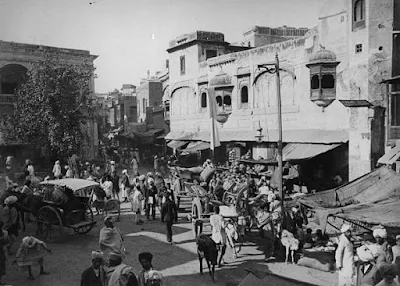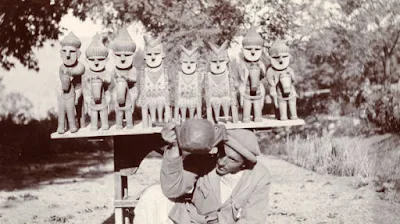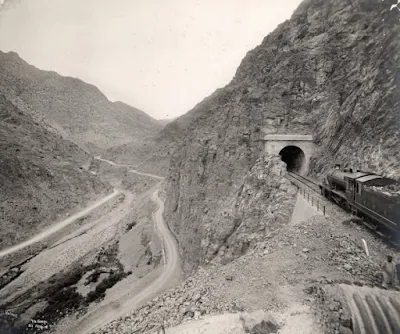An Afghan border crossing at the Khyber Pass manned by British troops during the Third Anglo-Afghan War, it is marked by a sign which reads 'it is absolutely forbidden to cross this border into Afghan territory'. (Photo by Hulton Archive/Getty Images)
1919: Machine gun section of a Border Regiment protecting roadworkers from attacking tribesmen on the North West Frontier, India. (Photo by Topical Press Agency/Getty Images)
circa 1910: Spectators at a military parade in Rawalpindi, Punjab province, northern Pakistan. (Photo by Sean Sexton/Getty Images)
circa 1912: A street scene in Lahore. (Photo by Scott/Hulton Archive/Getty Images)circa 1912: People at the Anarkali Bazaar at Lahore. (Photo by Scott/Hulton Archive/Getty Images)
1912: A man on a camel in Lahore, India (later Pakistan). (Photo by Hulton Archive/Getty Images)
Spectators at a military parade in Rawalpindi, Punjab province, northern Pakistan, circa 1910. (Photo by Sean Sexton/Getty Images)
Sniper in the N.W.F.P. (North West Frontier Province, now Pakistan). Photograph taken early 20th century. (Photo by Culture Club/Getty Images)
Snake charmers in Karachi, Pakistan. Photograph from early 20th century. Two men play pipes, in two baskets two cobras rise from the ground. (Photo by Culture Club/Getty Images)
Afghan tribesmen, Khyber Pass. Photograph taken early 20th century. The Khyber Pass connects Afghanistan and Pakistan, between the Spin Ghar mountains. (Photo by Culture Club/Getty Images
Dead raider, Khyber Pakhtunkhwa. Photograph from early 20th century. Caption reads: 'the end of a raider. N.W. Frontier'. The North West Frontier Province, now known as Khyber Pakhtunkhwa, is one of the four provinces of modern day Pakistan. (Photo by Culture Club/Getty Images)
Campbellpore, Pakistan, 20th century. (Photo by The Print Collector/Print Collector/Getty Images)
A procession passing through the Delhi Gate, Lahore, Pakistan, 1913. The Delhi Gate is located within Walled City of Lahore. It was built during the Mughal period and is one of thirteen gates of the Inner City. Stereoscopic card. Detail. (Photo by The Print Collector/Print Collector/Getty Images)
A temple in Nowshera, India, 1916-1917. (Photo by The Print Collector/Print Collector/Getty Images)
Hyderabad, road to Charminar 'Mosque of the Four Minarets' and 'Four Towers'. - probably in the 1910s (Photo by Haeckel collection/ullstein bild via Getty Images)
Hyderabad, locals cross the bridge to the entrance of the city. - probably in the 1910s (Photo by Haeckel collection/ullstein bild via Getty Images)
Alexander at the Battle with Porus', 326 BC. (c1912). The forces of Alexander the Great (356-323 BC) combat those of the Indian rajah Porus (active 327-315 BC) on the banks of the River Hydaspes, (now the River Jhelum in Pakistan). Although Porus had the advantage of battle elephants, which the Greeks had never encountered before, Alexander still defeated Porus. From The Romance of India, edited by Herbert Strang. [Hodder & Stoughton, London, c1912]. Artist Unknown(Photo by The Print Collector/Getty Images)
UNSPECIFIED - APRIL 23: Interior of the Temple of Indra in Lahore, sketch for Act V, Scene I of the opera The King of Lahore by Jules Massenet, Season 1899, from 500 stage design sketches in five volumes, 1919, by Carlo Ferrario (1833-1907). (Photo by DeAgostini/Getty Images)
INDIA - 1917/01/01: A convey of armoured Rolls Royce vehicles climb through the Khyber Pass. Background to this image: With the threat of War looming in Europe, Edward Fitzgerald Charlesworth volunteered to join the Territorial Army that was being raised in Britain for coastal defense. These part-time soldiers trained at weekends and under an Act of Parliament no part of this force was to 'be carried or ordered to go out of the United Kingdom.' With the outbreak of the Great War in August 1914 Lord Kitchener, Secretary of State for War, asked for volunteers to serve abroad. The response from E.F. Charlesworth's Battalion, the 4th Queen's was reported to be 'very satisfactory' and the volunteers were soon deployed to India to replace the regular British Army troops who were fast being transported to the battlefields of Europe. The 1st/4th Queen's arrived in Lucknow, via Bombay where they completed their 'War Training'. From published accounts there is no question that the soldiers posted to India during this period were craving for a call to the European front. The Times in 1916 was to write: 'The men who have been sent to garrison the outposts of Empire would undoubtedly have chosen, if the choice had been theirs, to take their chances on the European battlefields with the Allies.' E.F. Charlesworth recorded much of what he saw from the moment he boarded the ship in Southampton. His camera documented the life of British soldiers in India, their families, the local population, landscapes and landmarks. On his death these images were passed on to his Grandson Peter, who retains copyright to these rare historical images. Date of this image is estimated but lies within the period 1915 to 1919. (Photo by Edward Fitzgerald Charlesworth/Peter Charlesworth Collection/LightRocket via Getty Images)
INDIA - 1917/01/01: British and Indian soldiers with what is believed to be an armoured Rolls Royce near Jamrud Fort at the foot of the Khyber Pass. Background to this image: With the threat of War looming in Europe, Edward Fitzgerald Charlesworth volunteered to join the Territorial Army that was being raised in Britain for coastal defense. These part-time soldiers trained at weekends and under an Act of Parliament no part of this force was to 'be carried or ordered to go out of the United Kingdom.' With the outbreak of the Great War in August 1914 Lord Kitchener, Secretary of State for War, asked for volunteers to serve abroad. The response from E.F. Charlesworth's Battalion, the 4th Queen's was reported to be 'very satisfactory' and the volunteers were soon deployed to India to replace the regular British Army troops who were fast being transported to the battlefields of Europe. The 1st/4th Queen's arrived in Lucknow, via Bombay where they completed their 'War Training'. From published accounts there is no question that the soldiers posted to India during this period were craving for a call to the European front. The Times in 1916 was to write: 'The men who have been sent to garrison the outposts of Empire would undoubtedly have chosen, if the choice had been theirs, to take their chances on the European battlefields with the Allies.' E.F. Charlesworth recorded much of what he saw from the moment he boarded the ship in Southampton. His camera documented the life of British soldiers in India, their families, the local population, landscapes and landmarks. On his death these images were passed on to his Grandson Peter, who retains copyright to these rare historical images. Date of this image is estimated but lies within the period 1915 to 1919. (Photo by Edward Fitzgerald Charlesworth/Peter Charlesworth Collection/LightRocket via Getty Images)
Pathan Girl, North West Frontier, The term 'Pathan' is a corruption of the term Pashtun meaning a member of one of the inter-related tribes on both sides of the Pakistan-Afghanistan border; they are famous for their independence and enjoy almost total autonomy in Pakistan's tribal areas, Pakistan, 1919. (Photo by R.B. Holmes/Royal
Pathan Man, North West Frontier, The term 'Pathan' is a corruption of the term Pashtun meaning a member of one of the inter-related tribes on both sides of the Pakistan-Afghanistan border; they are famous for their independence and enjoy almost total autonomy in Pakistan's tribal areas, Pakistan, 1919. (Photo by R.B. Holmes/Royal Geographical Society/Getty Images)
Amir's elephants resting at Landi Kotal, North West Frontier, Pakistan, 1919. (Photo by E. Richmond/Royal Geographical Society/Getty Images)
The mosque at Lahore - Punjab - Pakistan, Pakistan, 1919. (Photo by E. Richmond/Royal Geographical Society/Getty Images)The Fort at Attock, The fort at Attock was built in the 1580s by Emperor Akbar. It is now used as a Pakistan army base, Pakistan, 1919. (Photo by R.B. Holmes/Royal Geographical Society/Getty Images)
Mohammedans at mid-day prayer, Pakistan, 1919. (Photo by R.B. Holmes/Royal Geographical Society/Getty Images)
A Chitrali of the higher classes, North West Frontier, Pakistan, 1918. (Photo by J. Sulley/Royal Geographical Society/Getty Images)
Laden pack transport on one of the roads near Kala Drosh, North West Frontier, Pakistan, 1918. (Photo by J. Sulley/Royal Geographical Society/Getty Images)
A Chitrali sheep dog, North West Frontier, Pakistan, 1918. (Photo by J. Sulley/Royal Geographical Society/Getty Images)
Government horse and mule transport in camp, North West Frontier, Pakistan, 1918. (Photo by J. Sulley/Royal Geographical Society/Getty Images)
At the crest of the Dorah Pass, North West Frontier, Pakistan, 1918. (Photo by J. Sulley/Royal Geographical Society/Getty Images)
Lal Kafir images, North West Frontier, Pakistan, 1918. (Photo by J. Sulley/Royal Geographical Society/Getty Images)
Lower Bari-Doab Canal, river sluices view from downstream, opening ceremony in the Sutlej Valley, Pakistan, April 1913. (Photo by F. Bremner/Royal Geographical Society/Getty Images)
A Kalash funeral march, North West Frontier, A handwritten caption reads, 'Kalash funeral march, widow sobbing away on a effigy of her dead husband. Men jumping round with spears and axes and girls performing a kind of waltz', Pakistan, 1918. (Photo by J. Sulley/Royal Geographical Society/Getty Images)
Turkoman refugee from Russia, North West Frontier, Pakistan, 1918. (Photo by J. Sulley/Royal Geographical Society/Getty Images)
Sandeman Memorial Hall in Quetta, Baluchistan, Pakistan, 1911. (Photo by Erich Zugmeyer/Royal Geographical Society/Getty Images)
Early Arab tombs of Bhavani near Las Bela in Baluchistan, Pakistan, 1911. (Photo by Erich Zugmeyer/Royal Geographical Society/Getty Images)
Railway through Bolan Pass in Baluchistan, Pakistan, 1911. (Photo by Erich Zugmeyer/Royal Geographical Society/Getty Images)
Crocodile dug out alive from its dry season burrow at Lyari, Pakistan, 1911. (Photo by Erich Zugmeyer/Royal Geographical Society/Getty Images)
Ascent to Darkot Pass with crevassed glacier in foreground, Third Expedition to Central Asia, Pakistan, 1913. (Photo by Aurel Stein/Royal Geographical Society/Getty Images)
Lower Bari Doab canal - level crossing at Bulloki on river Ravi, view from downstream of the sluices across the river, Pakistan, 1913. (Photo by F. Bremner/Royal Geographical Society/Getty Images)
Bridge platform building at Michni being replaced by a bridge, Kabul River, North West Frontier, Pakistan, 1919. (Photo by T.R.J. Ward/Royal Geographical Society/Getty Images)
One days bag, Shadiani, There is no official date for this image, possibly taken c. 1910, Pakistan, 1910. (Photo by C.E. Bruce/Royal Geographical Society/Getty Images)
Mari Nawab signing the terms with General Hardy, Pakistan, 1918. (Photo by C.E. Bruce/Royal Geographical Society/Getty Images)
Guns captured by the Maris from the British Relieving Column in 1843, Title continues:- 'who went to where Brown who was beleaguered by Maris. The Relieving Column failed. Brown had to surrender. Their guns were lost and surrendered by the Mawab to me in 1918', Pakistan, 1918. (Photo by C.E. Bruce/Royal Geographical Society/Getty Images)
View, Lahore, Pakistan, circa 1918. (Photo by Royal Geographical Society/Getty Images)











































































No comments:
Post a Comment